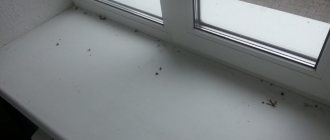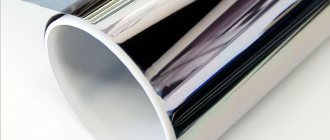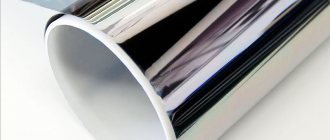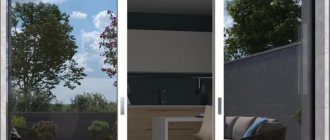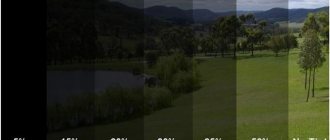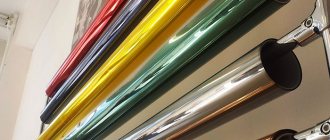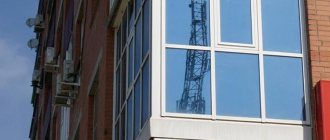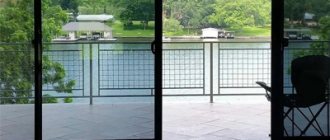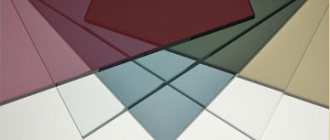Do you want to protect the room and people in it from the scorching sun? Close the windows on the first floor from prying eyes? Is it easy to maintain a comfortable microclimate and privacy? A mirror film with a one-way visibility effect on windows will help you achieve all this! We are ready to quickly and efficiently tint residential, commercial, and office premises with such film, and do the work with a guarantee and a long service life.
You only need to choose a film from the options presented:
Prices for installation of film with one-way visibility effect
| Color | vendor code | Price |
| Silver mirror | Silver 15/20 | from 600 rub./m2 |
| Silver mirror | Silver 35 | from 600 rub./m2 |
| Silver mirror | Silver 50 | from 600 rub./m2 |
| Gray-mirror | Gray 10 | 750 RUR/m2 |
| Gold-mirror | Gold 15 | 750 RUR/m2 |
| Bronze mirror | Bronze 15 | 750 RUR/m2 |
| Blue-mirror | Blue 15 | 750 RUR/m2 |
| Green-mirror | Green 15 | 750 RUR/m2 |
*prices are valid for orders of at least 10 m2
For faster ordering, please call
+7
Examples of our work
Certificates
Mirror film on windows is your assistant in the fight:
- With the scorching rays of the sun . It protects the room and people from overheating.
- With UV radiation harmful to the eyes . The film blocks it almost completely.
- With a violation of privacy, prying eyes from the street . The room should be darker than outside so that visibility is one-way.
- With annoying glare on monitors, mirrors, screens . The film eliminates this effect of bright sun.
- With discomfort, heat in the room, stuffiness . When creating an optimal microclimate, the first thing to do is protect yourself from the sun.
- With dull wallpaper, faded curtains, stunted plants . With everything that is subject to the destructive effects of blinding sunlight.
- With small and large fragments in case of a broken window . The film base will reliably hold the glass mass on itself.
Stick the film on the windows and forget about many problems!
How to choose a film
Self-adhesive products perform various functions and differ in appearance and internal structure.
Types of window films:
- sun protection;
- protective (anti-vandal);
- mirror;
- decorative;
- architectural
If the main requirement for the coating is the lack of visibility of the interior and residents from the street, the windows are sealed with decorative material. But, such a design will hide daylight.
Mirror and sun protection will provide the owners of the house with privacy during daylight hours, but in the evening and at night they will have to use thick curtains or close the shutters.
Sun protection film
There are mirror and tint.
Covering to protect light openings from the sun performs a number of functions:
- prevents heating of rooms;
- darkens the interior space;
- protects furniture and finishing materials from fading.
Sun control material provides one-way visibility from inside to outside. But in the dark, when the level of illumination in the house is higher than outside, the mirror effect disappears. Therefore, with the onset of dusk, you will have to close the curtains, blinds or shutters.
The self-adhesive screen blocks solar radiation and transmits up to 75% of natural light. During the cool season, the tinting material accumulates heat inside the house.
Protective film
The coating will provide privacy and safety to owners of country houses and residents of apartments on the lower floors.
The product will replace unattractive window grilles due to the polymer thickness of 115-600 microns. The material will protect the glass from hooligans and burglars. Windows on which such film is made are difficult to break. But if this happens, the fragments will not fly away. Material protection class - A1-A3.
There are films to protect homes from explosions and fires. Fire-retardant coating inhibits the spread of fire and carbon monoxide. Such protection will not hurt in a wooden house. In the event of a fire, the glass unit will remain intact for 45 minutes. The glass can be broken from the inside and you can get out of the burning room.
Even if a bullet hits the glass, when it hits the film, its speed will decrease. But, such a coating is applied during the production of windows; independent installation is impossible.
For country houses and apartments, class A1 material is suitable. If glass protected by a coating breaks, the fragments will not fly away. The coating almost does not allow air to pass through, which is necessary to maintain and spread fire.
Mirror film
Mirror screens are made from high-quality polymers. The material increases the density of the glass, protects from the views of neighbors and passersby during daylight hours, and prevents overheating of the air in the house: the mirror coating reflects light.
The mirror product does not let UV rays into the house and does not overheat the air. The facades of furniture and finishing materials do not fade or delaminate, and the heat generated in the room is retained.
Mirror film for windows can be standard or painted. When making a painted coating, the metal surface is laminated with a colored material for a variety of designs.
Coatings vary in strength and level of shading. Pricing depends on the main characteristics of the product.
Other types: protective, architectural and also made with a mirror surface.
Decorative film
Decorative film for windows - opaque. It features a variety of designs, so you can make a coating for any interior style.
Windows are covered with decorative screens:
- in interior doors and above them;
- in bathrooms;
- in baths and saunas.
The material does not transmit light, visibility will be absent both from the inside and from the outside. To bring in daylight and provide privacy, you can stick a white or colored decorative covering only on the lower part of the window.
The decorative coating does not have protective properties against solar radiation and does not help retain heat.
If you stick the product on a window facing south, the material will quickly lose color. Also, cracks may appear on the surface.
This type of tint film is not suitable for an apartment with picturesque views and windows due to the opacity of the material.
Architectural film
Architectural canvas is a tinting material for window structures. Protects glass from external influences, prying eyes, and serves as a decorative element in the design of glass products: windows, doorways, various surfaces.
Types of architectural film:
- mirror:
- transparent;
- matte;
- colored.
Architectural coating protects a house or apartment from various types of radiation, from burglars, and helps maintain privacy. Apply to the inner surface of the window.
Where is one-way visibility film commonly used?
- On the first floors of residential and office premises . It is glued to all windows so that it is not visible from the street, to ensure privacy.
- On the sunny side in shopping, entertainment, and business centers . It is the film that can reliably “mirror” scorching rays and prevent overheating in the premises.
- In offices, for zoning space, monitoring employees . Using mirror film, you can delimit workplaces and provide management with visual control over them.
- In greenhouses, on verandas, in winter gardens, where it is important to maintain a uniform microclimate . Even in hot summers you can protect yourself from the blinding sun, but not lose the brightness of lighting, which is important for plants.
- In security premises, checkpoints, security booths, security rooms . Everywhere where it is necessary to eliminate unnecessary “visibility” from the street and from other rooms.
Properties of glass
Such half-mirror cameras really exist and are used for secretly monitoring people (for the purpose of monitoring behavior or espionage), or to protect a room from prying eyes.
Such glass must be transparent to allow light to pass through (so that viewers can see the image). At the same time, it must have mirror properties.[>
Some of the light falling on the glass is reflected by the front and back surfaces of the glass, some passes through the glass, and some is absorbed, heating the glass and then being emitted in the infrared spectrum. The amount of light passing through the glass is determined by the light transmittance ( T
- the proportion of transmitted light), the amount of reflected light is determined by the reflection coefficient (
R
- the proportion of reflected light).
Moreover, R
+
T
≤ 1 (i.e., light incident on the medium either passes through the glass, or is reflected, or is absorbed inside the medium and heats it).
According to Fresnel's optical laws
, reflection coefficients depend only on the optical properties of the medium (refractive index
n
) and on the angle of incidence of the beam.
Since there is air on both sides of the glass under conditions suitable for human life (and its optical properties depend only on humidity, temperature and pressure and change very little), the glass will have the same properties (refractive indices n
, reflection
R
, transmittance
T
, absorption
K
) both for light rays coming from the “hidden” space and into it.
Then how can you achieve the effect of one-way visibility?
Should I glue the film myself or entrust it to the experts?
Let's compare!
For self-installation:
- It is important to correctly determine the window size/amount of film so as not to overpay.
- the surface must be prepared for the film to last long.
- You need to glue carefully and carefully to avoid cracks, swelling, and peeling.
- It is advisable to use special equipment so that the surface is perfectly flat.
Film sticker by “Safe Glass” craftsmen:
- accurate measurements : regardless of your room, window area and number.
- neat work : without damage to the film, cracks, blisters and scratches.
- quick sticker : a full range of work without wasting time and lengthy preparation.
- high-quality result : with minimal effort from the customer and time.
- inexpensive : and with exact compliance with what the client wants to receive.
One way mirror production
How does such a one-way mirror differ from a regular one and how to make it?
Regular mirrors
- This is usually glass with a reflective coating applied to its back side (various alloys of tin, silver, copper, titanium or aluminum). At the same time, the spraying is very dense and the spray layer is thick.
Mirrors with one-way transparency
are made similarly, but the coating layer is thin and allows some light to pass through.
An alternative option is to apply a translucent mirror film
. It can be applied to existing glazing.
The cost of both methods is the same, and the principle of operation is the same (see above). Resistance to mechanical stress (scratches, shocks), temperature conditions and humidity is approximately the same.
Main difference
— mirror coating is done in the workshop, automatically. Therefore, the quality of the product does not depend on the craftsman performing the work. But such glass is produced only in specialized workshops and for some time (depending on the production technology).
Mirror film
can be applied locally, incl. on existing glazing. However, applying the film requires good skills and special tools to avoid defects during gluing (bubbles, peeling, various irregularities, foreign inclusions or dust, etc.). Also, the mirror film can be applied together with a reinforcing protective film.
